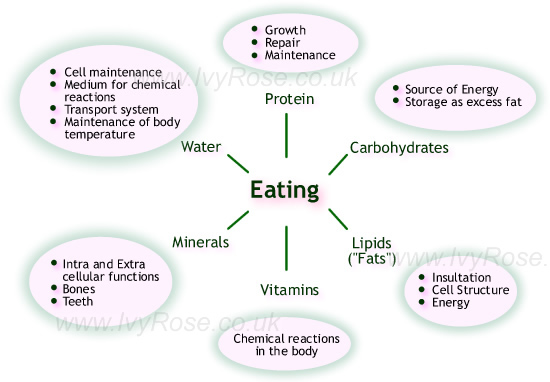The Characteristics of Life
The following is a typical introduction to a first-level course in Biology (incl. Human Biology) and Human Anatomy and Physiology.
Biology is the study of living beings including plants, animals and fungi.
Many courses in biology and related subjects start
by defining living things by listing
the "Characteristics
of Life" and examples of each of
these characteristics for plants, animals, humans, or
whatever categories apply to the main subject and level
of the course.
As courses in Human
Anatomy and Physiology concentrate on the human
species, the following table includes comments on each
of the characteristics as applied to humans:
Characteristics of Life: |
The comments below apply to the example of a human (biological organism). |
|

|
Eating

|
 |

|
Movement |
Examples include movement
of limbs, facial
tissues, materials
through the digestive system,
and so on. |

|
Reproduction |
This is the means by which the species as a whole continues
beyond the life-span of any single individual. The human
reproduction process involves the exchange of genetic information
and material. |

|
Breathing |
Breathing involves the intake of air from outside the
body, absorption of oxygen gas (O2) for use within
the body, and the release of the waste product carbon dioxide gas (CO2) from
the body.
The action of breathing is described on the pages about the respiratory system. |

|
Growing |
The term "growing" refers to the increase in size of a
person during his/her childhood, typically until the age
of about 18 years. It can be affected by lifestyle
factors - such as a balanced diet, by genetic factors
- e.g.
coming from a relatively "short" or "tall" family, and also
by certain hormonal conditions that affect growth/development. |

|
Waste (excretion) |
This term refers to removal from the body of waste products
that may have been formed by metabolic processes. Examples
include:
- Breathing out (of the body) carbon dioxide (C2O)
and water (H2O),
the waste products from aerobic
respiration.
- Sweating, removal of waste products from the body via
the skin.
- Urinating. (Urea is nitrogenous waste, i.e. it is from
proteins.)
- Defecating. Strictly, materials that leave the body by
the process of defecation are undigestable food materials
- rather than waste products formed by the metabolic processes that occur in the body. Their colour is due to the undigestable
food itself, and to the effects of any excess bile.
|

|
Secretion |
Examples of substances secreted from the human body
include:
- Hormones (somtimes described simply as "chemical messengers")
- Sebum (from sebaceous glands), e.g. ear wax.
|

|
Circulation |
In human there are two circulation systems:
- Primary Circulation = Blood
Circulation,
and
- Secondary Circulation = The Lymphatic System.
|
|
Note that the "characteristics of life" headings
in the list above are layman's terms rather than medical
terms and are listed in no particular order. Comparable
lists in textbooks vary. If this topic forms part of
your syllabus check the characteristics and terminology
specified for your particular course.
Some biology courses and textbooks list a specific number of basic characteristics of life, e.g. 6 characteristics of life or 7 characteristics of life. The comments included above includes examples of the basic characteristics of life for the case of humans as opposed to e.g. apes (which are similar in many respects), plants or even bacteria.
See also characteristics of fungi.












